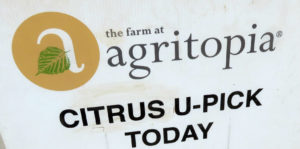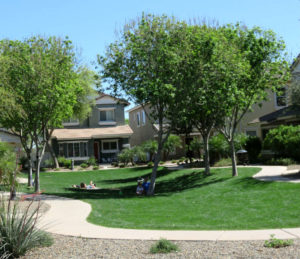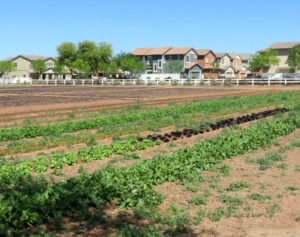The first and only time I visited Phoenix was twenty-five years ago. All I remembered from that trip were endless strip malls, six-lane arterials, lots of double left-turn lanes, roads filled with cars, and cascading water fountains. The bubbling fountains at the entrances to subdivisions and in front of office buildings perplexed me, because I knew I was in the middle of the desert! The Phoenix climate was too hot and dry and the built environment was too auto dependent for me. Even so, it’s a nice place to visit in the depths of a soggy Seattle winter. A family wedding was my opportunity to explore Phoenix again. I went looking forward to finding someplace that would comfort my Northwest sensibilities.
After touching down and renting the much needed automobile to ensure that I could get to the wedding festivities, I found myself again driving on the never ending highways, with graceful looping ramps and being distracted by strip malls. Concrete sidewalks bounded both sides of the road on every city street, which is a sign of good urban planning design, but sadly no one was using them. There were no dog walkers, runners, or cycle riders, just a ribbons of sidewalk paralleling the continuous traveled way. Where would I find people? Where would I find community? I was happy when I found a little bit of Arizona heaven at Agritopia®.

Waiting to Pick Citrus
Agritopia® is located in Gilbert, Arizona about 30 miles east of downtown Phoenix in an area that was once home to ranches and farms. It’s located directly adjacent to a Highway 202 exit ramp the main loop highway around Phoenix, which connects to the interstate highway system. Agritopia® sits on land that was homesteaded in 1927 and actively farmed for 70 years by the original homesteaders and later the Johnston family. Realizing in the late 1990’s that suburbia was creeping ever closer to their commodity crop farm, rather than just selling the farm and abandoning the land’s agricultural heritage, the family decided to do something different. The family to create their own development concept by incorporating food growing into their community design.
Agritopia®’s Community
Turning into the dirt parking area on a Saturday morning in mid-March, the knee-level sign, “Citrus U-Pick Today,” beckoned me. The parking area was nearly two-thirds full with sedans, mini-vans, and trucks. Walking away from a large undeveloped commercial concern behind me and passing by snout-nosed garages on the far side of a large empty field, I walked through the parked cars towards a cluster of large trees. My ears perked when I overheard a grandmother laden with bags of fruit announce with enthusiasm to her grandkid, “This was fun! I’m definitely going to watch for this u-pick next year!”
Just beyond the parking area, beneath the cooling tree canopy, I found what I was looking for—a place where people gathered, spent time with their families and friends, and met their neighbors. At Joe’s FarmGrill’s front door, there was a line of 20 people waiting to get served hometown fare made in part with super local on-farm Agritopia® products. Joe’s FarmGrill occupies the Johnston family farmhouse, which was originally a 1960’s modern home with a sloped roof and large windows. (This was not the farmhouse of my New England heritage!) Other former farm structures have more traditional wood clad siding that have been remodeled and re-purposed for an office, a farm retail space, and a coffee shop that was bustling with almost as many patrons as Joe’s FarmGrill.

Citrus U-Pick at the Farm
I kept following the U-Pick signs to the orchard entrance. A young man took my money and gave me a sack to pick 10 pounds of the most delicious citrus—Lisbon lemons and Blood-Ruby and Arizona Sweets oranges. Trees were in full bloom, perfuming the grove in a delicate orange blossom scent, while at the same time there was plenty of ripe citrus to pick. Coming from a northern climate, it was incongruous that a tree was blossoming at the same time as fruit could be picked. I learned later that oranges can take from four to 18 months to reach maturity depending on its variety and water and weather conditions. Orange trees also blossom several times a year and the tree knows when to drop excess fruit to ensure a healthy tree and crop. The three-acre orchard is planted with 150 trees with 24 different varieties of peach, plum, apple, orange, grapefruit, mandarin, apricot, and lemon trees all ready for picking at different times of the year. This is obviously not a commercial fruit operation as the orchard is quite small and very diversified, but rather a developer added amenity to help build community and set this development apart from subdivisions. As I wandered through the grove looking for another tree to pick, I saw families with children and young people on a date—taking selfies, of course!

Enjoying the Commons
Once my citrus bag was stashed in my car, I walked around the Agritopia® neighborhood with enthusiasm, as I was really liking this development. In some sections of the development, there are more traditionally styled homes with big front porches facing a tree-lined street with sidewalks. Each home has their own driveway with access to a rear detached garage and a fenced backyard. In another neighborhood, there are more innovative urbanist homes fronting on a common green space. Garages are attached to the home and accessed from a back alley. Several folks were lounging underneath a tree in the common lawn between the homes, while young kids were throwing a ball. There was a sense of community—common ground—where the neighboring households could get to know their neighbors. Perhaps they would plan a neighborhood picnic or pick-up soccer game on the lawn?
Agritopia® is also designed to serve all generations, which is a healthy neighborhood model. Age restricted community have been the rage, but as more baby boomers age, they haven’t necessarily wanted to be isolated with only old people but rather have a yearning to be around young energy. GENERATIONS at Agritopia® is a full-service, independent living, assisted-living, and memory eldercare facility located in the geographical heart of the community. GENERATIONS is next door to the religious-based elementary and middle schools, which could potentially offer opportunities for students and elders to interact.

Living Next to the Farm
My highlight was the seven acres of farm and community gardens located in the heart of the development, dedicated to food production, and easily accessed by the neighborhood. Several folks were out in their garden plots digging in the dirt, getting ready for the upcoming growing season. The commercial row crop vegetable farm looked freshly planted with irrigation lines set, even though nothing had sprouted yet. Recently leafed out grape vines entwined the arbor creating a shadow and respite from the hot Arizona sun. White picket fences, some supporting grape vines, separated the individual garden plots from the walking paths and the commercial farm operation. As I walked back to my car, I had found a sense of peace and contentment from my Agritopia® visit.
What Makes Agritopia® Special
Agritopia® is an incredibly, livable community, because it’s a place to be happy and easy to be part of a bigger community. With two on-site restaurants, a retail farmstand, a school, and community gardens along with an adjacent city-owned dog park and on-site playgrounds, there were plenty of spots where neighbors could meet neighbors. As I walked by Joe’s FarmGrill on the way back to my car, there was still a line to get in, confirming that I had found a little bit of Arizona heaven.
Kathryn Gardow, P.E., is a local food advocate, land use expert and owner of Gardow Consulting, LLC, an organization dedicated to providing multidisciplinary solutions to building sustainable communities. Kathryn has expertise in project management, planning, fundraising, and civil engineering, with an emphasis on creating communities that include food production. Kathryn is a Washington Sustainable Food and Farming Network board member and on the Urban Land Institute–Northwest District Council’s Center for Sustainable Leadership planning team. Kathryn’s blog muses on ways to create a more sustainable world and good food!

